Series A Sales Strategies


Raising Series A funding is exciting.
But here's the uncomfortable truth: most startups that secure Series A funding still struggle to build a scalable, repeatable sales motion.
The problem isn't always the product or the market. It's that many founders approach sales the same way they did in their pre-seed or seed stage (or don’t even approach sales 🙃), and that simply doesn't work anymore.
At Series A, the expectations change. Investors want to see predictable growth, efficient customer acquisition, and a clear path to profitability.
But how to actually go beyond your expectations and be able to scale is something unknown to a lot of founders.
This guide breaks down everything you need to know about building a winning sales strategy at the Series A stage in 2025.
What Makes Series A Sales Different?
At seed stage, you were likely doing founder-led sales, hustling to close every deal yourself, iterating on messaging, and figuring out product-market fit. CEO do it all.
That scrappy approach can get you funded, but now you need to scale.
Series A is the inflection point where startups must transition from founder-led sales to a scalable, repeatable sales process.
You're expected to hire sales reps, implement systems, and demonstrate that your go-to-market strategy works without you being in every deal.
The key shifts at Series A include:
- Hiring your first sales team: You'll need to bring on Sales Development Representatives (SDRs) and Account Executives (AEs) who can execute your playbook.
- Building repeatable processes: Document what works, create sales playbooks, and implement CRM systems to track every interaction.
- Focusing on efficiency: Investors want to see improving unit economics. That means optimizing Customer Acquisition Cost (CAC) and Customer Lifetime Value (LTV).
- Scaling beyond your network: You can't rely on warm intros anymore. You need systematic outbound and inbound strategies that generate pipeline predictably.
Core Components of a Winning Series A Sales Strategy
1. Define Your Ideal Customer Profile (ICP)
Stop trying to sell to everyone. At Series A, precision matters more than volume.
Your ICP should be crystal clear:
- Company size: Are you targeting startups, mid-market, or enterprise?
- Industry: Which verticals convert best and have the highest LTV?
- Pain points: What specific problems does your product solve?
- Buying signals: What triggers indicate a company is ready to buy?
Use data from your early customers to identify patterns. Which accounts closed fastest? Which have the highest retention? Which generated the most referrals? Double down on companies that fit those profiles.
Pro tip: Don't just define one ICP. Segment your market into Tier 1 (dream clients), Tier 2 (good fit), and Tier 3 (low priority). Allocate your sales resources accordingly.
2. Build a Scalable Outbound Motion
Outbound remains one of the most effective ways to generate pipeline for B2B startups. But in 2025, generic spray-and-pray cold emailing doesn't work anymore.
Here's how to build an outbound engine that actually performs:
Layer your outbound approach:
- Tier 1 prospects: High-touch, personalized sequences combining email, LinkedIn, and sometimes cold calls
- Tier 2 prospects: Semi-automated sequences with light personalization
- Tier 3 prospects: Fully automated nurture campaigns
Use the right tech stack:
- For lead generation and enrichment, consider tools like Apollo, Clay, or FullEnrich to build high-quality prospect lists
- For email outreach, platforms like Instantly, Smartlead, or Lemlist help you scale while maintaining deliverability
- For LinkedIn outreach, HeyReach automates connection requests and messaging at scale
Focus on deliverability:
Your emails are worthless if they land in spam. Use email warm-up services and proper domain authentication (SPF, DKIM, DMARC) to maintain high inbox placement rates.
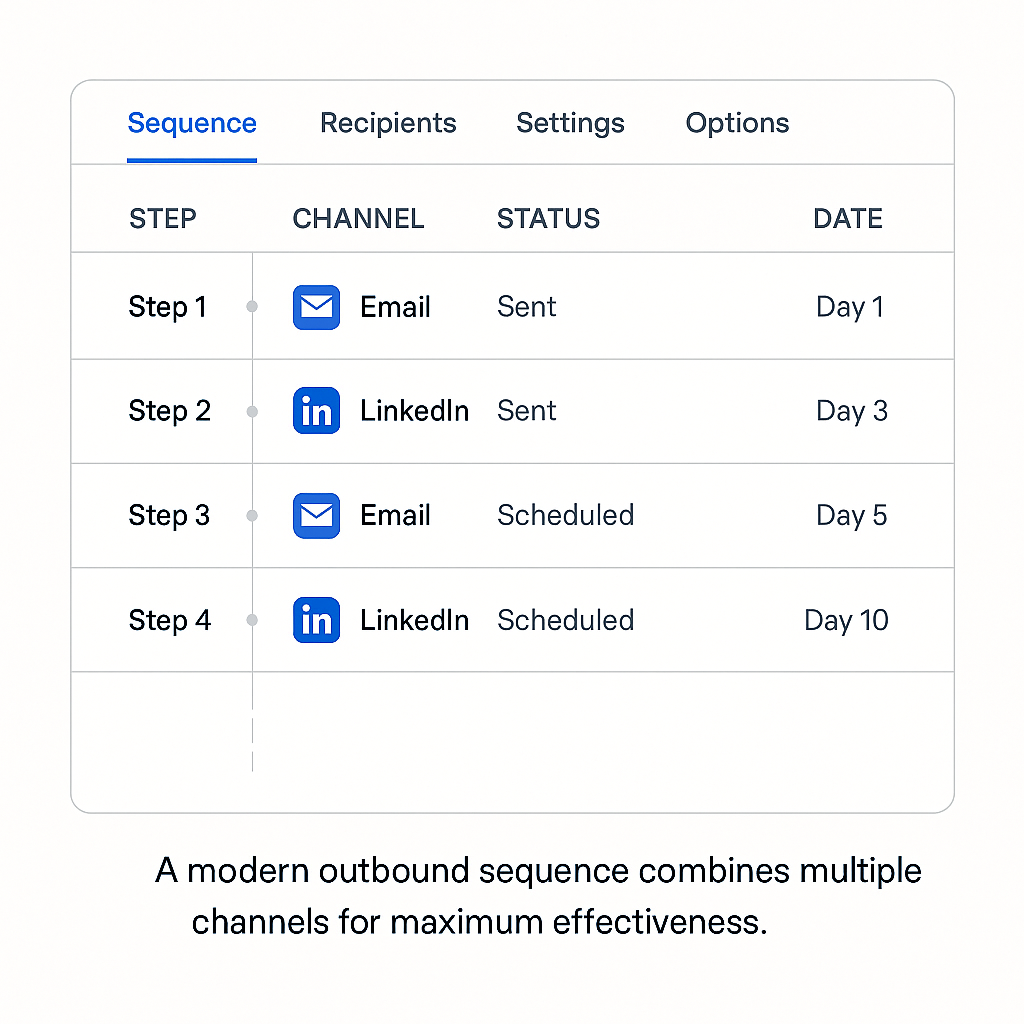
3. Implement Intent-Based Selling
The best sales teams don't just blast prospects randomly. They use intent signals to prioritize accounts that are actively in-market.
Intent signals include website visits, job changes, funding announcements, and hiring activity. When a prospect shows multiple intent signals, they're significantly more likely to convert.
How to leverage intent signals:
- Use tools like RB2B or Vector to identify anonymous website visitors and trigger personalized outreach
- Track job changes with Trigify or Pronto to reach decision-makers at new companies
- Monitor job postings related to your solution as buying signals
- Follow funding announcements and product launches as trigger events
Example workflow:
- A VP of Sales from your ICP visits your pricing page
- Your system automatically enriches their contact data
- An SDR receives an alert and sends a personalized message within 1 hour
- The prospect replies because the timing is perfect
This approach can significantly improve reply rates compared to cold outreach 🥶.
4. Create a Predictable Inbound Engine
Outbound gets you quick wins, but inbound builds sustainable pipeline. At Series A, you should be investing in content and SEO to generate organic leads.
Content strategy for Series A startups:
- Publish 6-10 high-quality blog posts per month targeting high-intent keywords
- Create comparison content (your tool vs. competitors) to capture bottom-of-funnel searches
- Develop use case guides that demonstrate clear ROI
- Build a tool / calculator / free service that provides immediate value and captures emails
Consider using a tool like Ahrefs for keyword research and Surfer for content optimization.
Lead capture optimization:
- Add a lead magnet popup after 60 seconds of browsing
- Use exit-intent popups with compelling offers
- Create gated resources (templates, guides, toolkits) for email capture
- Implement visitor identification tools like Instantly or Vector to re-engage anonymous traffic via email or LinkedIn
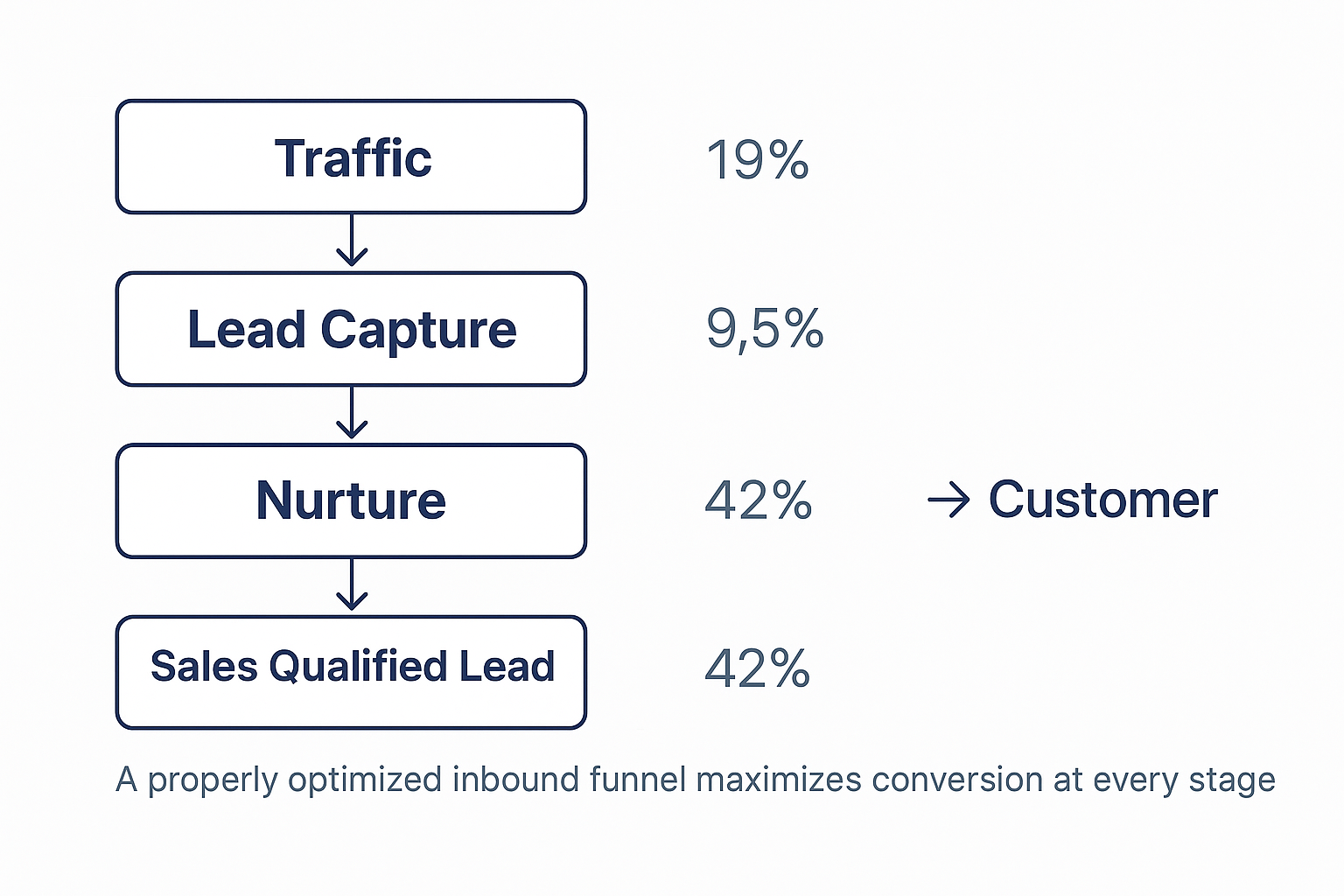
5. Hire and Structure Your Sales Team
One of the biggest mistakes Series A founders make is hiring the wrong sales profile or structuring their team inefficiently.
Who to hire first:
- Sales Development Representatives (SDRs): Focus on prospecting and booking meetings
- Account Executives (AEs): Handle demos, negotiations, and closing deals
- Sales Engineer (if technical product): Provides technical expertise during demos
Before scaling your sales team, make sure all your existing reps are at 100% capacity. Adding more salespeople to an inefficient system just multiplies problems.
Tier your accounts strategically:
Assign your Tier 1 dream clients to your best AE for high-touch, personalized outreach. Use automation and GTM engineers to handle Tier 2 and Tier 3 accounts efficiently.
Compensation structure:
Consider offering higher commission rates for self-sourced deals versus inbound or SDR-sourced opportunities. This incentivizes AEs to build their own pipeline rather than waiting passively for leads.
6. Implement the Right Sales Tech Stack
Your sales tech stack should enable efficiency, not create complexity. Here's a framework for Series A startups:
Essential tools:
- CRM: Attio, or Pipedrive or Hubspot (can be hard to manage early on…) for managing your sales pipeline
- Sales Engagement: Instantly, Smartlead, or Lemlist for cold email at scale
- Enrichment: FullEnrich, Enrow, or Icypeas for finding contact data
- LinkedIn Automation: HeyReach or Aimfox for scaling LinkedIn outreach
- Meeting Intelligence: Attention or Circleback for call recording and AI-powered insights
Find the best sales tools using our tool finder.
Budget considerations:
With under $250/month, go all-in-one with Instantly or Lemlist. At $500-$1,500/month, add Clay for enrichment and Apollo for database access.
Above $1,500/month, layer in intent data tools like Common Room and proposal software like Qwilr.
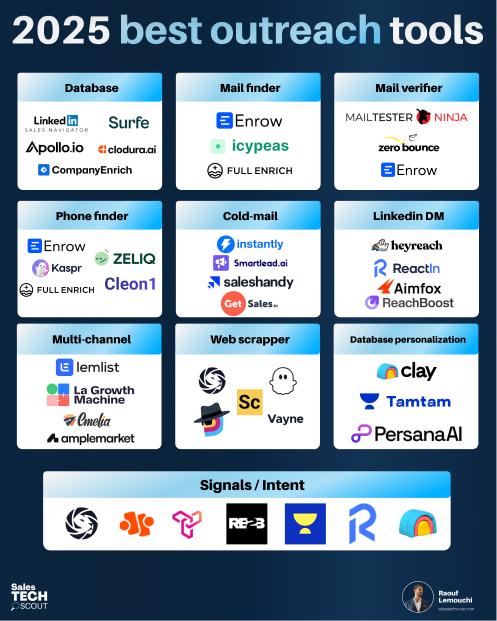
Common Series A Sales Mistakes to Avoid
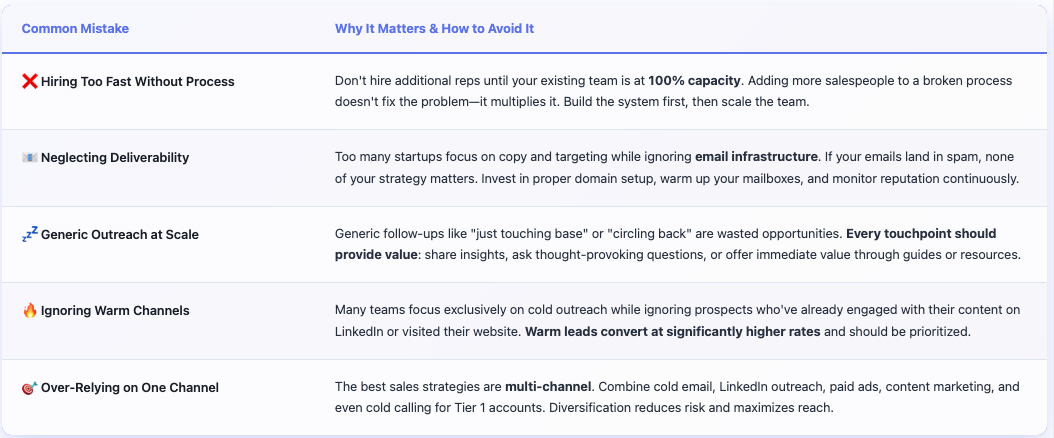
Advanced Tactics for 2025
AI-Powered Sales Workflows
AI tools like Claygent can automate prospect research at scale, finding personalization data for every lead. Tools like Octave help craft personalized messaging tailored to your ICP automatically.
Social Selling on Autopilot
Use tools like Teamfluence or Breakcold to automatically identify and engage with prospects who interact with your LinkedIn content. A like, comment, or share is a buying signal that shouldn't be ignored.
Revenue Operations from Day One
Don't wait until Series B to hire a RevOps person. At Series A, having someone focused on data hygiene, process optimization, and reporting will pay dividends as you scale.
Key Metrics to Track
Your investors will scrutinize these numbers, so you should too:
- CAC (Customer Acquisition Cost): Total sales and marketing spend divided by new customers acquired
- LTV (Lifetime Value): Average revenue per customer over their entire relationship with you
- LTV:CAC Ratio: Should be at least 3:1 for healthy unit economics
- Sales Cycle Length: Time from first touch to closed deal
- Win Rate: Percentage of opportunities that close successfully
- Pipeline Coverage: Pipeline value divided by quota (aim for 3-4x coverage)
- Ramp Time: How long it takes new reps to become productive
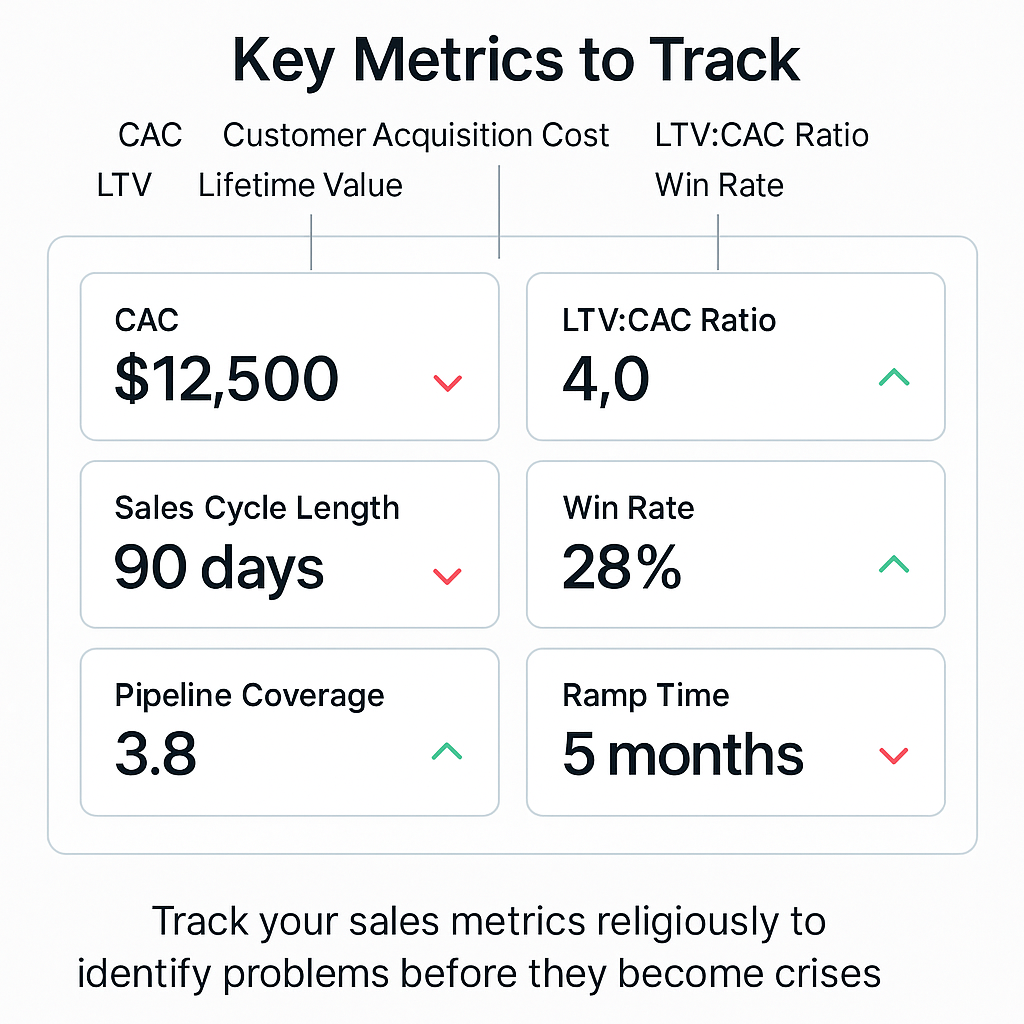
Frequently Asked Questions
How many sales reps should a Series A startup hire?
Start with 1-2 SDRs and 1-2 AEs. Only add more once they're consistently hitting capacity and quota. Premature scaling is one of the most common reasons Series A startups burn through their runway.
Should we focus on inbound or outbound at Series A?
Both. Outbound gives you control and immediate pipeline, while inbound builds sustainable, cost-efficient growth over time. The ratio depends on your product, market, and resources, but most successful Series A companies invest in both.
How do we know if our sales process is actually scalable?
If a new AE can ramp to 70%+ of quota within 90 days using your documented playbook, you're on the right track. If every deal requires founder involvement or custom solutions, you're not ready to scale yet.
What's the biggest difference between seed and Series A sales?
At seed, you're figuring out what works through founder-led sales. At Series A, you're documenting what works and hiring people to execute your proven playbook.
How important is sales enablement at this stage?
Critical. Create a sales playbook documenting your ICP, messaging framework, objection handling, demo flow, and pricing strategy. Every new hire should have a clear onboarding path to productivity.
Should we hire expensive, experienced reps or cheaper, hungry reps?
For your first 1-2 AEs, consider hiring someone with experience who can help build your process. After that, you can bring on hungrier, less expensive reps to execute the playbook the experienced hire helped create.
Conclusion: Build Systems, Not Heroes
One shot vs recurring comes to mind. The goal at Series A isn't to find superhuman salespeople who can close anything through sheer force of will. The goal is to build a repeatable, scalable system that produces predictable results.
Document everything. Test continuously. Measure religiously. Iterate quickly.
Your funnel should generate qualified leads consistently through a multi-channel approach combining LinkedIn, SEO, paid ads, and cold outbound.
Optimize every conversion point from first touch to closed deal.
The startups that succeed at Series A and beyond aren't the ones with the flashiest product or the most charismatic founder. They're the ones that built a machine that consistently converts prospects into customers, regardless of who's operating it.
Ready to build that machine? Check out SalesTech Scout's Tool Finder to discover the exact tools top-performing Series A companies use to scale their sales.
Subscribe to Our Newsletter
To Never Miss a Thing

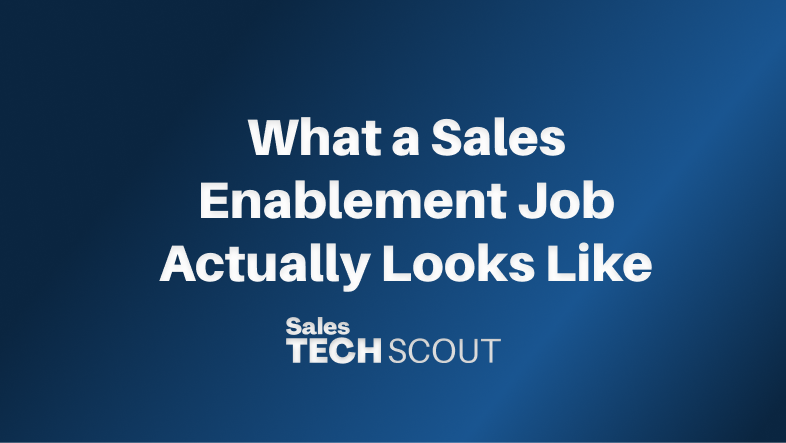




.avif)


